https://www.freepressjournal.in/business/now-power-your-gadgets-with-sea-waves-energy
Wave energy could become the next big source of energy
Rebello Dominic | RN Bhaskar
Statistically Wave Energy alone can produce twice the amount of electricity that the world produces now
A nuclear disaster survivor, Inna Braverman is the Founder and CEO of Eco Wave Power (EWP) that uses innovative technology for production of clean electricity from ocean and sea waves. She was
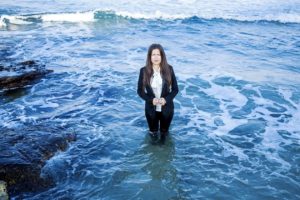
born in Ukraine in 1986 and two weeks later, the Chernobyl nuclear reactor exploded, causing the largest nuclear disaster in histor. She suffered from the negative impact of the polluted air and had a respiratory arrest. Luckily, her mother, a nurse, gave her mouth to mouth resuscitation which saved her life. She was lucky, but other children and adults were not as lucky.
Though in the early stages, her company, EWP has contributed significantly towards creating awareness to this sector, contributing to the development of the regulatory and legislative frameworks to accept and adopt wave energy and contributing to the scientific research of the wave energy field.
In conversation with Dominic Rebello and RN Bhaskar of the Free Press Journal, Inna Braverman shares her journey, her projects and her future plans for the company. “EWP is pioneering in the wave energy field and I hope our journey will inspire and trigger some clear actions, that will spread beyond Sweden and Israel, among which: the promotion of clean energy , support for innovative ideas, easy and clear regulatory framework for renewables, which will lead to a better future for our children,” says Braverman.
The journey
Inna Braverman has a strong passion for renewable energy because of her personal story. She was two weeks old when the Chernobyl nuclear reactor exploded, which incidentally was the largest nuclear disaster in history. She survived and got a second chance in life and a feeling that there is a purpose to her life. She grew up and studied political science in Israel with an aim to make a positive change in the world through politics but life had different plans. After completing her education she got the job of a Hebrew-English translator in a renewable energy company. There she got to know about wind energy, solar energy and wave energy. Wave energy was something that all the engineers and scientists really believed in, but, nobody could make it commercially viable. She then took up the challenge and decided to make the impossible possible.
She kept on researching how other companies had failed or why their technologies did not work. She then came up with her own ideas and concepts to make wave energy in a much simpler and easier way.
As fate would have it, she met her co-founder David Leb — a serial entrepreneur, businessman and angel investor — at a social event. David had invested in a surf hotel in Panama and there he witnessed the power of waves and thought surely we can do much more with the waves other than marine sports.
Together they developed a concept – neither of them were engineers – and now wanted engineers to design a prototype and write the software required to run it.
So they went to Ukraine, identified some good engineers and began the company in 2010-11 and also registered a patent the same year. Today EWP holds 17 patents of which 12 are approved. It has patents pending in Israel, United States, the European Union and an international Patent Cooperation Treaty (PCT) for harvesting clean electricity from the waves. The company has raised $27 million and is listed on two financial markets NASDAQ, Stockholm and NASDAQ US.
“Sometimes the best businesses come from people who think outside of the box. For example, Jack Ma of Alibaba fame is a school teacher and has nothing to do with e-commerce,” says Braverman.
The initial projects
In 2014, EWP signed a 5MW PPA (Power Purchase Agreement) with the Government of Gibraltar and the Gibraltar Electricity Authority. The construction was co-funded by The EU Regional Development Fund as well as private investment groups. In May, 2016, EWP and the Government of Gibraltar held an official opening ceremony of the newly constructed wave energy power station on the east side of Gibraltar.
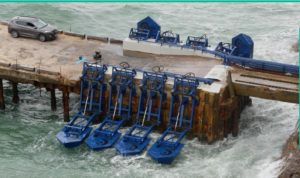 Now, at a former World War II Ammunition Jetty, sits the initial 100KW of a 5MW power station. EWP’s Gibraltar project is the first grid connected project and a significant step towards the commercialisation of the EWP technology. Today, the station is the only grid-connected wave energy array in the world, operating through a PPA (Power Purchase Agreement).
Now, at a former World War II Ammunition Jetty, sits the initial 100KW of a 5MW power station. EWP’s Gibraltar project is the first grid connected project and a significant step towards the commercialisation of the EWP technology. Today, the station is the only grid-connected wave energy array in the world, operating through a PPA (Power Purchase Agreement).
In Jaffa Port, Israel, EWP operates an off-grid pilot power station for system improvement and modification and R&D. The station allows for the testing of new system components and floater designs &  materials, with an eye towards continuously improving the EWP wave energy technology and maintaining EWP’s leading market position. The pilot station has been operating in Jaffa Port since 2014 and since its inception has been producing clean wave energy generated electricity for testing and study.
materials, with an eye towards continuously improving the EWP wave energy technology and maintaining EWP’s leading market position. The pilot station has been operating in Jaffa Port since 2014 and since its inception has been producing clean wave energy generated electricity for testing and study.
In September 2015, the Jaffa Port station was recognized as a “Pioneering Technology” by the Chief Scientist of the Israeli Ministry of National Infrastructures, Energy, and Water Resources- Dr. Bracha Halaf. In October 2018, EWP was awarded a grant by the Ministry of National Infrastructures, Energy, and Water Resources for the expansion of the pilot station to 100KW and its connection to the national Israeli electrical grid. The expanded station will be the first wave energy power station in the history of the state of Israel to successfully connect to the electrical grid.
EWP is also undertaking the expansion of the project in partnership with Electricite De France (EDF), with whom EWP has signed a Joint Venture agreement in May, 2019.
For the third project, EWP has signed a concession agreement with 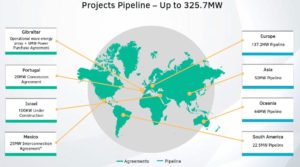 APDL (A Administração dos Portos do Douro, Leixões e Viana do Castelo) for the use of an area suitable for the development of wave power project in four areas up to a capacity of 20MW.
APDL (A Administração dos Portos do Douro, Leixões e Viana do Castelo) for the use of an area suitable for the development of wave power project in four areas up to a capacity of 20MW.
“We just received the licenses for the first, one megawatt and we hope to start construction during this year. This will be the first project that will be of a megawatt scale power station and actually start operating not as R&D where all the preliminary steps have been done by other companies before, but actually like in commercial scale,” said Braverman.
Future projects
EWP currently holds a significant project-pipeline of more than 325.7MW worldwide. The company’s pipeline projects are mostly located in markets which already have a significant interest in implementing wave energy technologies as part of their renewable energy mix. EWP is seeking to bring its innovative technology to additional countries which are suitable for wave energy production worldwide, such as the U.S., New Zealand, Canada, and South Africa all of which have large potential for the implementation of wave energy technologies.
 On January 5, 2022, EWP announced that the first set of floaters and supporting structures for the grid-connected EWP-EDF One project were delivered to the Jaffa Port project site in Israel. The floaters were delivered in accordance with the collaboration agreement entered between EWP-EDF One Ltd. and Lesico Ltd. The project’s next step is the upcoming installation of the first floaters on the Jaffa Port breakwater.
On January 5, 2022, EWP announced that the first set of floaters and supporting structures for the grid-connected EWP-EDF One project were delivered to the Jaffa Port project site in Israel. The floaters were delivered in accordance with the collaboration agreement entered between EWP-EDF One Ltd. and Lesico Ltd. The project’s next step is the upcoming installation of the first floaters on the Jaffa Port breakwater.
“By delivering our first set of floaters and supporting structures, we are making significant progress toward the first grid-connected wave energy array installation in Israel” said Inna Braverman. “Preparation for the installation of the floaters on the external side of the Jaffa Port breakwater is in the final stages and we are relishing the prospect of being operative soon in the Mediterranean waves.”
EWP delivered the floaters and supporting structures to the project site with trucks, as opposed to the traditional use of expensive ships and divers for equipment delivery for offshore wave energy installations. This further emphasizes the simplicity of the onshore nature in the work programming of Eco Wave Power’s floaters 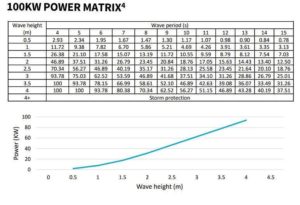 shipment and installation technology.
shipment and installation technology.
“Our goal is to generate electricity during the third quarter of this year,” added Braverman. “This is a key milestone in the overall development of the EWP technology, and the results are expected to enable us to take important steps toward the commercial rollout of our pioneering technology.”
When completed, the EWP-EDF One wave energy project will include 10 floaters connected to one conversion unit, which is already installed onsite. The EWP-EDF One conversion unit is located on land, similar to a normal power station, which enables easy access for operation and maintenance. This highlights the significant advantages of the EWP onshore technology, in comparison to offshore solutions.
How it works
The floaters draw energy from incoming waves by converting the rising and falling motion of the waves into a clean energy generation process. More precisely, the movement of the floaters compresses and decompresses hydraulic pistons which transmit bio-degradable hydraulic fluid into land located accumulators. In the accumulators, pressure is built, which rotates a hydraulic motor, which in turn rotates the generator, and then the electricity is transferred into the grid, via an inverter.
 The fluid, after decompression, flows back into the hydraulic fluid tank, where it is then re-used by the pistons, thus creating a closed circulatory system. The system commences production of electricity from wave heights of 0.5 meters. The whole operation of the system is controlled and monitored by a smart automation system. Also, when the waves are too high for the system to handle the floaters automatically rise above the water level and stay in the upward position until the storm passes. Once the storm passes, the floaters return to operation mode.
The fluid, after decompression, flows back into the hydraulic fluid tank, where it is then re-used by the pistons, thus creating a closed circulatory system. The system commences production of electricity from wave heights of 0.5 meters. The whole operation of the system is controlled and monitored by a smart automation system. Also, when the waves are too high for the system to handle the floaters automatically rise above the water level and stay in the upward position until the storm passes. Once the storm passes, the floaters return to operation mode.
Plans for India
“The Indian market is very interesting for us because it has many different locations like Maharashtra, like Gujarat, which boasts of very large coastlines. According to studies by the government of India, it has a very large wave energy potential that is not yet utilized,” said Braverman.
EWP is in discussion with a number of organizations in India. Currently, it is in collaboration discussions with Non-conventional Energy Development Corporation of Andhra Pradesh Limited (NEDCAP) for the implementation of wave technology in Andhra Pradesh. The company is looking to enter a collaboration agreement with NREDCAP that will assist EWP in securing the site and funding for a pilot in Andhra Pradesh and a large-scale PPA.
EWP is also in collaboration discussions with Agency for New and Renewable Energy Research and Technology (ANERT) and are exploring how both the organisations can work together to implement the system in Kerala.
“Usually we penetrate new markets with partnerships exactly like we’re doing in the new project in Israel with EDF and the French national electrical company. In India, Tata Power and Adani Power will be perfect partners for us and we will be glad to get in touch with them,” said Braverman.
“We can begin with a pilot project and then expand it. Let the citizens, the media, the investment companies see how it works. Many times no matter if it works in Gibraltar, no matter if it works in Israel, they want to see it on their land with all the regulations. So that’s why we penetrate the market through these kinds of partnerships,” she added.





























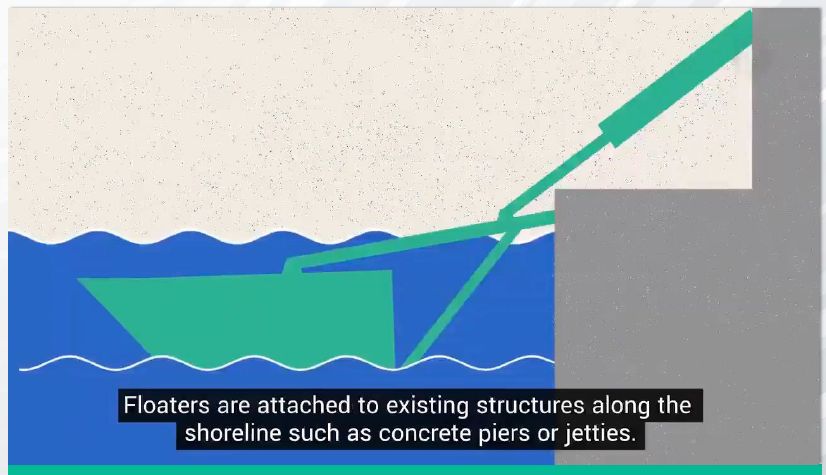










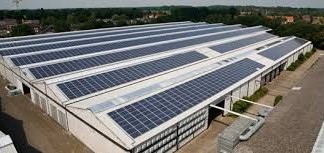
COMMENTS